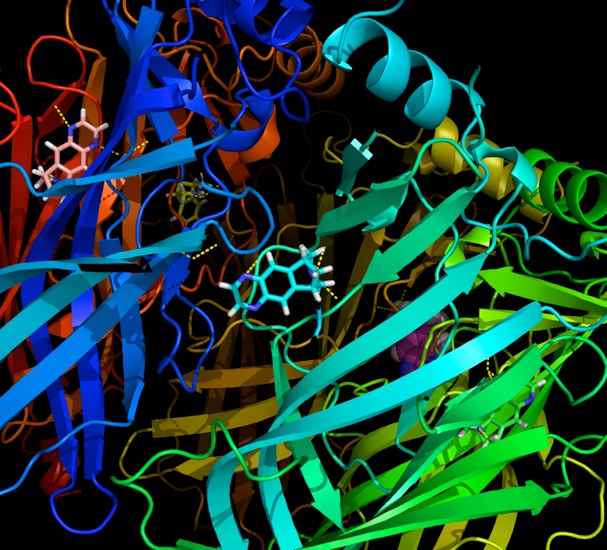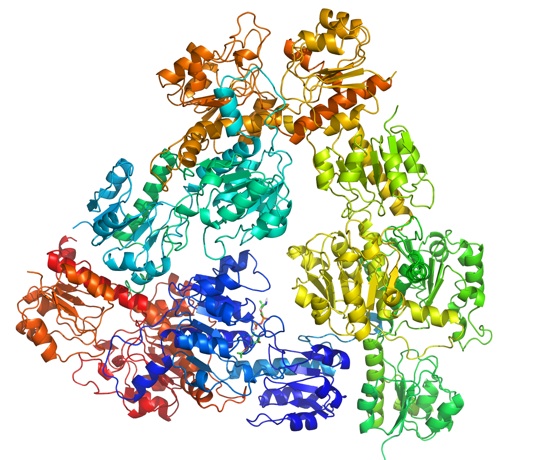Dr. Kara E. Ranaghan
I was awarded an MSci in Chemistry with study in continental Europe by the University of Bristol in 2002 and went on to obtain a PhD in Chemistry in 2006 (also from the University of Bristol). I became interested in studying enzyme mechanisms as an undergraduate project student and have now spent several years using computational techniques to explore aspects of enzyme reaction mechanisms and catalysis, focusing on the enzymes chorismate mutase, aromatic amine dehydrogenase, and methylamine dehydrogenase. How these enzymes achieve catalysis is at the centre of much lively debate: such as the role of tunnelling in enzyme reactions.

My current project involves studying the reaction mechanism of phosphite oxidation in phosphite dehydrogenase (PTDH). This biochemically unique reaction occurs as a nucleophilic displacement reaction on phosphorus with water/hydroxide as nucleophile and hydride as leaving group [1]. PTDH is currently used in the chemical industry as a cofactor regeneration system for the preparation of stereochemically pure compounds [2]. However, PTDH has a relatively low turn-over number, despite the fact that the chemical step has been shown to be rate-limiting [3] and the overall process has a considerable driving force at ~15 kcal/mol [1]. Efforts to improve the activity of the enzyme by in vitro evolution studies have not resulted in a protein with significantly enhanced catalytic properties [4]. A better understanding of the catalytic mechanism may provide the insights required to improve the enzyme for widespread use.
Several key active site residues have been identified through mutagenesis and crystallographic studies [5], but the identity of the catalytic base that activates the water molecule for the reaction remains unclear. Experimental evidence suggests that His292, should be protonated [6] and thus cannot act as a base. This has lead to the suggestion that Arg301 could be the catalytic base, a role not usually associated with arginines due to the high pKa of this residue. Another possible interpretation of the experimental data could be that His292 and phosphite exist in reverse protonation states i.e. phosphite protonated and His292 neutral. Only a small fraction of phosphite would exist in this form at pH 7, but this could also account for the relatively low activity of the enzyme. We are working alongside experimental biochemists in the lab of Wilfred van der Donk at the University of Illinois Urbana-Champaign to elucidate the reaction mechanism in this interesting enzyme.
References:
1.Vrtis, J. M.; White, A.; Metcalf, W. W.; van der Donk, W. A. "Phosphite Dehydrogenase: An unusual Phosphoryl Transfer Reaction" J. Am. Chem. Soc. 2001, 123, 2672-2673.
2.Vrtis, J. M.; White, A.; Metcalf, W. W.; van der Donk, W. A. "Phosphite Dehydrogenase, a New Versatile Cofactor Regeneration Enzyme" Angew. Chem. Int. Ed. Engl. 2002, 41, 3257-3259.
3.Fogle, E. J.; van der Donk, W. A. "Pre-steady-state studies of phosphite dehydrogenase demonstrate that hydride transfer is fully rate limiting" Biochemistry 2007, 46, 13101-13108.
4.Woodyer, R.; van der Donk, W. A.; Zhao, H. "Optimizing a biocatalyst for improved NAD(P)H regeneration: Directed evolution of phosphite dehydrogenase" Comb. Chem. High Throughput Screen. 2006, 9, 237-245.
5.Woodyer, R.; Wheatley, J.; Relyea, H.; Rimkus, S.; van der Donk, W. A. "Site-Directed Mutagenesis of Active Site Residues of Phosphite Dehydrogenase" Biochemistry 2005, 44, 4765-4774.
6.Relyea, H. A.; Vrtis, J. M.; Woodyer, R.; Rimkus, S. A.; van der Donk, W. A. "Inhibition and pH Dependence of Phosphite Dehydrogenase" Biochemistry 2005, 44, 6640-6649.
Publications:
1.K. E. Ranaghan, L. Ridder, B. Szefczyk, W. A. Sokalski, J. C. Hermann, and A. J. Mulholland. Mol. Phys. 2003, 101, 2695.
2.K. E. Ranaghan, and A. J. Mulholland. Chem. Commun. 2004, 1238.
3.K. E. Ranaghan, L. Ridder, B. Szefczyk, W. A. Sokalski, J. C. Hermann, and A. J. Mulholland. Org. Biomol. Chem. 2004, 2, 968.
4.B. Szefczyk, A. J. Mulholland, K. E. Ranaghan, and W. A. Sokalski. J. Am. Chem. Soc. 2004, 126, 16148.
5.F. Claeyssens, K. E. Ranaghan, F. R. Manby, J. N. Harvey, and A. J. Mulholland. Chem. Commun. 2005, 5068.
6.F. Claeyssens, J. N. Harvey, F. R. Manby, R. A. Mata, A. J. Mulholland, K. E. Ranaghan, M. Schutz, S. Thiel, W. Thiel, and H. J. Werner. Angew. Chem. Int. Ed. 2006, 45, 6856.
7.L. Masgrau, A. Roujeinikova, L. O. Johannissen, P. Hothi, J. Basran, K. E. Ranaghan, A. J. Mulholland, M. J. Sutcliffe, N. S. Scrutton, and D. Leys. Science 2006, 312, 237.
8.M. J. Sutcliffe, L. Masgrau, A. Roujeinikova, L. O. Johannissen, P. Hothi, J. Basran, K. E. Ranaghan, A. J. Mulholland, D. Leys, and N. S. Scrutton. Phil. Trans. Royal Soc. B 2006, 361, 1375.
9.L. Masgrau, K. E. Ranaghan, N. S. Scrutton, A. J. Mulholland, and M. J. Sutcliffe. J. Phys. Chem. B 2007, 111, 3032.
10.K. E. Ranaghan, L. Masgrau, N. S. Scrutton, M. J. Sutcliffe, and A. J. Mulholland. ChemPhysChem 2007, 8, 1816.
11.K. Senthilkumar, J. I. Mujika, K. E. Ranaghan, F. R. Manby, A. J. Mulholland, and J. N. Harvey. J. Royal Soc. Interface 2008, 5, S207.
12.K. E. Ranaghan, and A. J. Mulholland. Int. Rev. Phys. Chem. 2010, 29, 65.
13.K. E. Ranaghan, and A. J. Mulholland. Interdiscip. Sci. Comput. Life Sci. 2010, 2, 78.
14.R. Lonsdale, K. E. Ranaghan, and A. J. Mulholland. Chem. Commun. 2010, 46, 2354.
15.Q. Ren, K. E. Ranaghan, A. J. Mulholland, J. N. Harvey, F. R. Manby, and G. G. Balint-Kurti. Chem. Phys. Lett. 2010, 491, 230.



